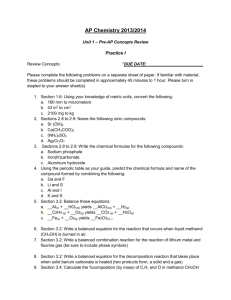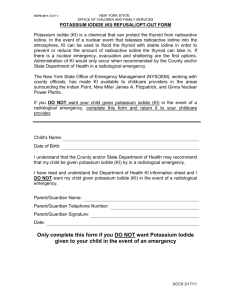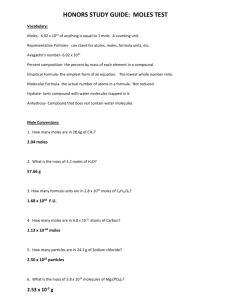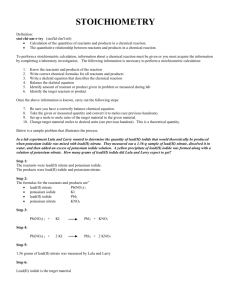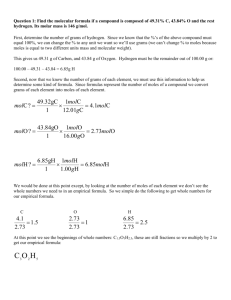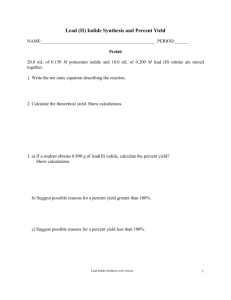Empirical Formula of a Lead Compound
advertisement
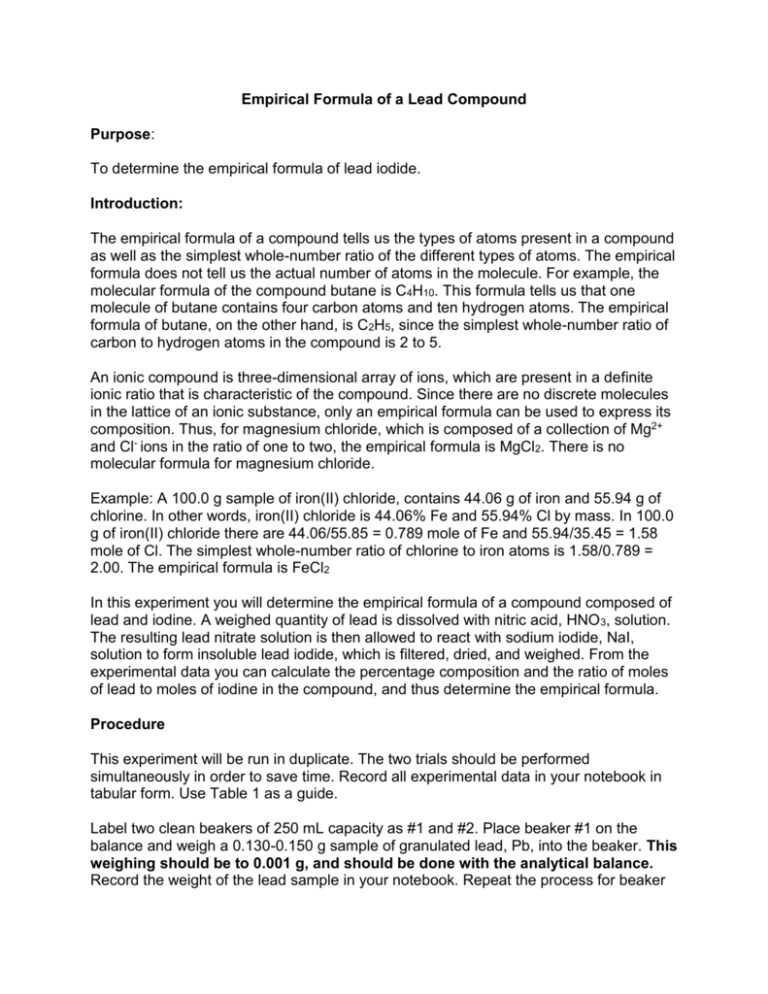
Empirical Formula of a Lead Compound Purpose: To determine the empirical formula of lead iodide. Introduction: The empirical formula of a compound tells us the types of atoms present in a compound as well as the simplest whole-number ratio of the different types of atoms. The empirical formula does not tell us the actual number of atoms in the molecule. For example, the molecular formula of the compound butane is C4H10. This formula tells us that one molecule of butane contains four carbon atoms and ten hydrogen atoms. The empirical formula of butane, on the other hand, is C2H5, since the simplest whole-number ratio of carbon to hydrogen atoms in the compound is 2 to 5. An ionic compound is three-dimensional array of ions, which are present in a definite ionic ratio that is characteristic of the compound. Since there are no discrete molecules in the lattice of an ionic substance, only an empirical formula can be used to express its composition. Thus, for magnesium chloride, which is composed of a collection of Mg2+ and Cl- ions in the ratio of one to two, the empirical formula is MgCl2. There is no molecular formula for magnesium chloride. Example: A 100.0 g sample of iron(II) chloride, contains 44.06 g of iron and 55.94 g of chlorine. In other words, iron(II) chloride is 44.06% Fe and 55.94% Cl by mass. In 100.0 g of iron(II) chloride there are 44.06/55.85 = 0.789 mole of Fe and 55.94/35.45 = 1.58 mole of Cl. The simplest whole-number ratio of chlorine to iron atoms is 1.58/0.789 = 2.00. The empirical formula is FeCl2 In this experiment you will determine the empirical formula of a compound composed of lead and iodine. A weighed quantity of lead is dissolved with nitric acid, HNO 3, solution. The resulting lead nitrate solution is then allowed to react with sodium iodide, NaI, solution to form insoluble lead iodide, which is filtered, dried, and weighed. From the experimental data you can calculate the percentage composition and the ratio of moles of lead to moles of iodine in the compound, and thus determine the empirical formula. Procedure This experiment will be run in duplicate. The two trials should be performed simultaneously in order to save time. Record all experimental data in your notebook in tabular form. Use Table 1 as a guide. Label two clean beakers of 250 mL capacity as #1 and #2. Place beaker #1 on the balance and weigh a 0.130-0.150 g sample of granulated lead, Pb, into the beaker. This weighing should be to 0.001 g, and should be done with the analytical balance. Record the weight of the lead sample in your notebook. Repeat the process for beaker #2. If any lead should spill in the process of weighing, clean it up and place in the waste lead container in the lab. Obtain approximately 20 mL of 3 M nitric acid, HNO3, solution in your graduated cylinder. CAUTION: HNO3 of this concentration can cause burns on skin or holes in clothing. If any spills occur, rinse the affected area thoroughly with water. (When nitric acid solution touches skin, the skin can turn a deep yellow color). [Dispose of excess HNO3 in the Aqueous Waste container]. Pour half of the 3 M HNO3 onto each sample of lead in beakers 1 and 2. Cover beaker 1 with a clean watch glass, and heat it gently over a hot plate in a fume hood until steam exits from under the watch glass. CAUTION: do not boil! Reheat periodically if gas evolution ceases, but do not boil. After all the lead has reacted, add approximately 20. mL of deionized water to each beaker. Heat the solution again until it steams, but do not boil. Remove the beaker from the hot plate, and let it stand for several minutes. Weigh (use the top loading balances in the lab!) approximately 0.8 g of sodium iodide, NaI, onto weighing paper. Do not take the NaI bottle into the analytical balance room. Transfer the NaI to a 100-mL or larger beaker, and add 40. mL of deionized water to this beaker. Heat this solution until it steams, allow the solution to cool slightly, and then add half of it slowly with stirring to beaker 1. (Save the other half for beaker 2). Allow the mixture to cool to room temperature while you repeat the procedure with beaker 2. At this point some of the lead iodide precipitate may consist of very fine crystals which will either clog the filter paper or pass through it. In order to cause the crystals to grow in size, heat the precipitate gently with constant stirring for 5-10 minutes, but do not boil the solution. Then allow the mixture to cool using an ice bath. Weigh a piece of filter paper to the nearest 0.001 gram and place it in a long-stemmed funnel. Use this filter paper to filter the lead iodide precipitated in trial 1. Use additional deionized water and a rubber policeman to wash the precipitate and help transfer it completely from the beaker to the filter paper. Remove the filter paper from the funnel. Place the filter on a labeled watch glass and allow it to air dry until next week. (Pour the liquid waste down the drain). Repeat the filtration for the solid of Trial 2. When the filter paper and solid for each run are completely dry, weigh the filter paper and solid for each trial, and record the masses. Results: Tables 1 and 2 below are meant to to serve as guides to assist you in your data collection and calculations. They are not to be pasted into your notebook. Perform the calculations in Table 2. Show each calculation clearly in your notebook. Table 1. Mass data for precipitation of lead iodide Trial 2 Trial 1 Mass of lead (g) Mass of filter paper (g) Mass of filter paper and lead iodide (g) Table 2. Calculations for the empirical formula of lead iodide Trial 1 Trial 2 Mass of lead used (g) Mass of lead iodide formed (g) Mass of iodine reacted (g) Moles of lead Moles of iodine Ratio: moles of iodine / moles of lead Average ratio: moles iodine / moles lead Empirical formula of lead iodide (Careful rounding off!!) Calculate the percent composition of lead and of iodide in your final product. % composition of lead = (grams Pb/grams PbIx) *100% Be sure to show one complete (very neat) sample for every calculation that you do. If you do your work on a spreadsheet, please include a copy of the table that has your formulas. Conclusion Your conclusion must have all of the following. Be sure to have complete sentences in well organized paragraphs. According to your results, what is the empirical formula of lead iodide? What is the percent composition of lead in your final product? What is the percent composition of iodide in your final product? Comment on the validity of the formula you determined (does it make sense?) Discuss all of the possible sources of error. Be sure to answer these questions with complete sentences in well organized paragraphs. If you had to prepare 20. mL of 3 M nitric acid, HNO3, solution from concentrated (15 M) HNO3, why would you add the concentrated HNO3 to water rather than vice versa? In this lab, you added water to a solution of 3M nitric acid. Why is that ok? (What is the difference between 15M and 3M nitric acid? M= moles/L) Why is it not necessary to weigh the sodium iodide, NaI, on an analytical balance? If your sample of lead iodide had not been dried thoroughly, would this cause the ratio of moles of lead to moles of iodide to be too high or too low? How would this affect the empirical formula? Indicate your reasoning clearly. How can the percent composition be used to determine the mole ratio?


